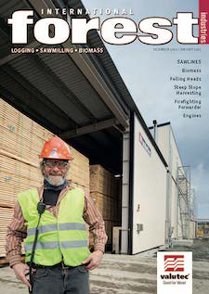EDITOR’S COMMENT Issue 78
Save our summer
There has been much to celebrate in the past month or so. Most notably, in the UK, where the International Forest Industries offices are based, the first person in the world received the breakthrough Pfizer vaccine in early December. By mid-month, the first patients in the US had also received a dose, along with a significant number of patients in other European nations.
This represents the realisation of a hope that most thought was beyond the reasonable back in March when COVID-19 became very real for much of the world. At that point, the usual vaccination development periods of somewhere between 10-15 years were used to taunt us, suggesting this would be a virus that would kill hundreds of thousands – potentially millions – and we would be asked to live with for the foreseeable future. At best, some said a vaccine could be rolled out within 18 months.
Maybe some of the doom and gloom can be put down to my colleagues in the mainstream press trying to sell papers, or maybe medical experts really were that downbeat, but some nine months after those first pessimistic guidance figures were released, we’re seeing the beginning of the end – it has been literally twice as expedient as the best-case scenario.
This success has prompted economic forecasters to revise upwards projections for 2021 from those published earlier in the year and, in fact, many of the forecasts for 2020 look likely to be far worse than the reality once the books are balanced from the current calendar.
The focus now, of course, is on the rollout of the Pfizer vaccine and others that are hot on its heels. The broad target in Europe, at least, is to have frontline workers and the vulnerable vaccinated by the end of the first quarter next year, with everyone else following by year end.
Though we are still probably a year away from a world in which COVID-19 doesn’t pose a fatal threat, we could be months away from a world where international travel is possible. This will depend on the policies of multiple governments – who will be operating with the knowledge those politicians that took the most conservative line on COVID-19 had the best approval ratings – but it is feasible that events could be back on the agenda by late in the first half of next year, albeit with various restrictions in place.
For those who haven’t yet guessed, I’m thinking explicitly about the prospect of forestry shows going ahead in some capacity in 2021. On the agenda (back on the agenda) in Europe alone are major sawmilling and forestry shows such as Ligna, Tra and Teknik, and KWF.
These international events are at the heart of our industry.
Sure, forestry has historically been a very domestic sector but more and more it has consolidated manufacturing resources and sought to grow the best technologies for a given region into global product suites. International meetings, therefore, represent an opportunity to both learn and to build business relationships that may underpin sales for a year – and beyond in some cases.
For our little team here at IFI, forestry events get us out of the office and into the industry, sometimes literally into the woods. We meet people, we learn about the latest technologies and we generally just enjoy ourselves.
For all the benefits an active vaccination programme will have for the global economy and the forestry sector, specifically, I’ll admit one of my first feelings was pure relief that my colleagues and I may once again be among industry this northern summer.
Enjoy
Chris Cann




